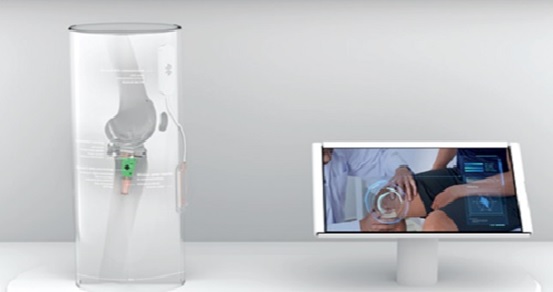World’s-First Multi-Sensor System For Knee-Implants
The system comprisng of various sensors improves surgery accuracy, detects infection early and enhances rehabilitation. Due to sedentary lifestyles, our bodies are not getting enough physical activity, especially moving from one place to another on feet. According to estimates by the Center for Orthopedic & Neurosurgical Care & Research, U.S., knee-implants will increase by 673 per cent by 2030. That is 3.5 million operations.[1]

Figure 1. World’s-First Multi-Sensor System For Knee-Implants
Figure 1 shows CEA-Leti, a CEA microelectronics research institute, will introduce a smart, integrated multi-sensor system for knee implants at CES 2022 that can help surgeons more accurately position the implant, dramatically reduce risk of follow-up surgery, and enhance rehabilitation. Called FollowKnee, the patented system integrates a deformation sensor, a pH sensor, a temperature sensor, and an accelerometer in a titanium tibial baseplate.
A more accurate implant fitting is achieved via the deformation sensor and accelerometer that guide the surgeon during the operation. In a world’s-first application connecting a pH sensor with living tissue, the system’s pH and temperature sensors detect infection early, while the deformation sensor and accelerometer also trigger an alert if they detect mechanical problems, such as loosening of the implant. [2]
CEA-Leti will demonstrate the sensors, electronics, and a reader integrated in a clear acrylic column representing a leg fitted with a complete knee prosthesis at CES, Jan. 5-8, Las Vegas, at Eureka Park booth 60655. A tablet will display the data collected by the sensors.
The FollowKnee project is financed by the French ANR program with 13 partners. The technology is expected to be adapted for hip and shoulder replacements. The researchers expect a first clinical study in 2024. [3]
"Accuracy is vital in knee-implant surgery," said Dr. Eric Stindel, an orthopedic surgeon at Brest Hospital, France, and a member of the project team. "By integrating the deformation sensor and the accelerometer, this innovative architecture gives both the surgeon and the patient peace of mind for a successful operation and follow-up." [4]
References:
- https://www.eetimes.com/optical-computing-chip-runs-hardest-math-problems-100x-faster-than-gpus/#
- https://www.electronicsforu.com/news/whats-new/optical-chip-efficiently-solve-complex-ai-problems
- https://www.i-micronews.com/optical-chip-solves-hardest-math-problems-faster-than-gpus/
- https://www.easybom.com/blog/a/optical-chips-that-can-efficiently-solve-complex-artificial-intelligence-problems
Cite this article:
Thanusri swetha J (2022), Optical Chip That Can Efficiently Solve Complex AI Problems, pp. 86

